Detailed Marketing Plan for Myanmar Airways International Expansion
VerifiedAdded on 2022/08/18
|17
|4280
|57
Report
AI Summary
This report details a comprehensive marketing plan for Myanmar Airways International, focusing on its expansion into new markets, including China and the Middle East. It begins with an executive summary and introduction, providing background on the airline's history and current operations. The internal environment is analyzed using SWOT and VRIO frameworks, assessing strengths, weaknesses, opportunities, and threats, as well as the value, rarity, imitability, and organization of its resources. The external environment is examined through a PESTEL analysis, considering political, economic, social, technological, environmental, and legal factors impacting expansion. The report then delves into STP analysis, including segmentation (demographic, psychographic, geographic, behavioral), targeting, and positioning. Consumer behavior is explored, covering psychological and personal factors, as well as the consumer buying process. A competitor analysis is conducted, followed by a discussion of marketing strategies, including traditional and digital marketing approaches, and marketing channels (B2B and B2C). The report concludes with company goals, objectives, strategies, a timeline, and a budget, providing a roadmap for Myanmar Airways International's future growth and market penetration.

Running head: MARKETING PLAN FOR MYANMAR AIRWAYS
MARKETING PLAN FOR MYANMAR AIRWAYS
Name of the Student
Name of the University
Author Note
MARKETING PLAN FOR MYANMAR AIRWAYS
Name of the Student
Name of the University
Author Note
Paraphrase This Document
Need a fresh take? Get an instant paraphrase of this document with our AI Paraphraser
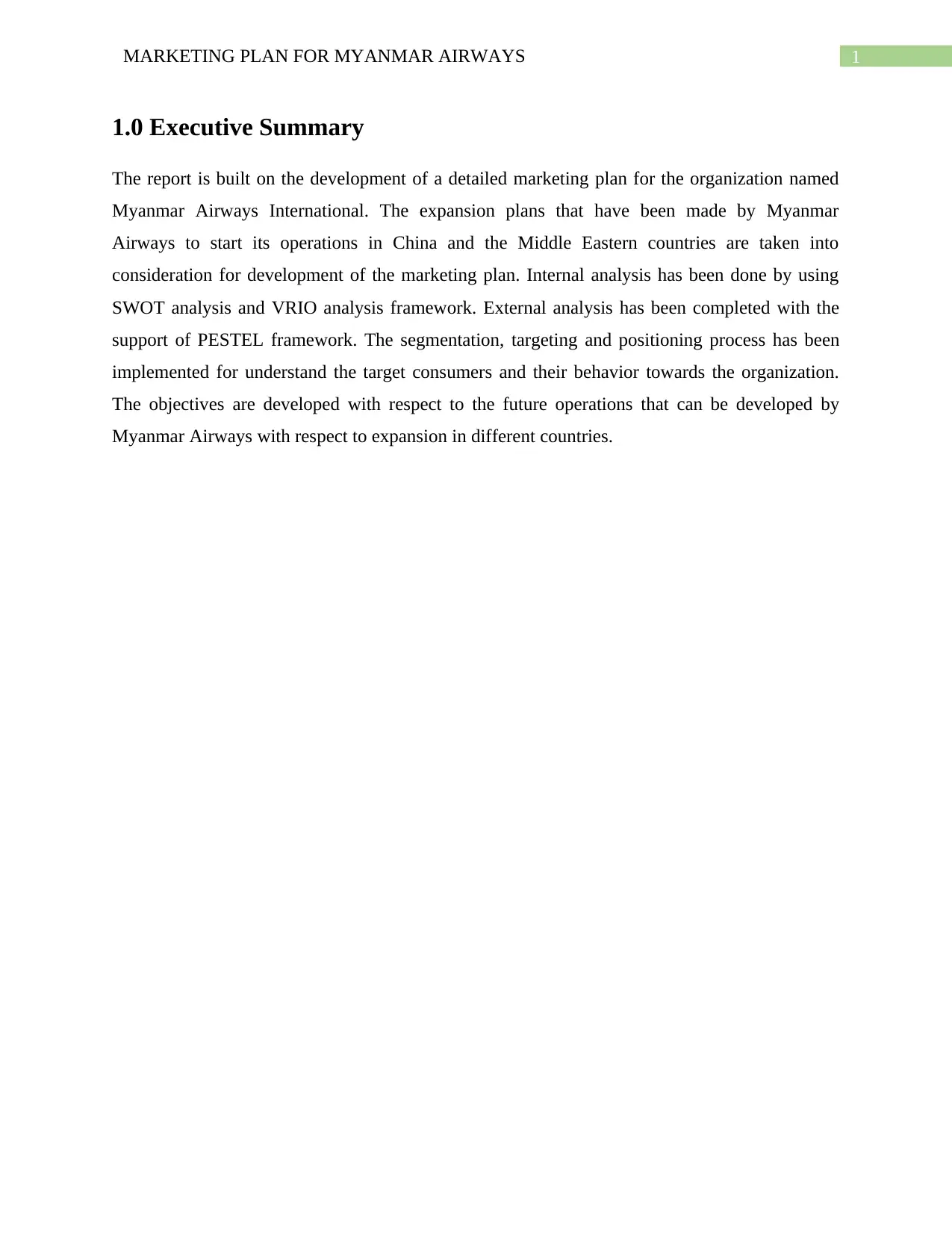
1MARKETING PLAN FOR MYANMAR AIRWAYS
1.0 Executive Summary
The report is built on the development of a detailed marketing plan for the organization named
Myanmar Airways International. The expansion plans that have been made by Myanmar
Airways to start its operations in China and the Middle Eastern countries are taken into
consideration for development of the marketing plan. Internal analysis has been done by using
SWOT analysis and VRIO analysis framework. External analysis has been completed with the
support of PESTEL framework. The segmentation, targeting and positioning process has been
implemented for understand the target consumers and their behavior towards the organization.
The objectives are developed with respect to the future operations that can be developed by
Myanmar Airways with respect to expansion in different countries.
1.0 Executive Summary
The report is built on the development of a detailed marketing plan for the organization named
Myanmar Airways International. The expansion plans that have been made by Myanmar
Airways to start its operations in China and the Middle Eastern countries are taken into
consideration for development of the marketing plan. Internal analysis has been done by using
SWOT analysis and VRIO analysis framework. External analysis has been completed with the
support of PESTEL framework. The segmentation, targeting and positioning process has been
implemented for understand the target consumers and their behavior towards the organization.
The objectives are developed with respect to the future operations that can be developed by
Myanmar Airways with respect to expansion in different countries.
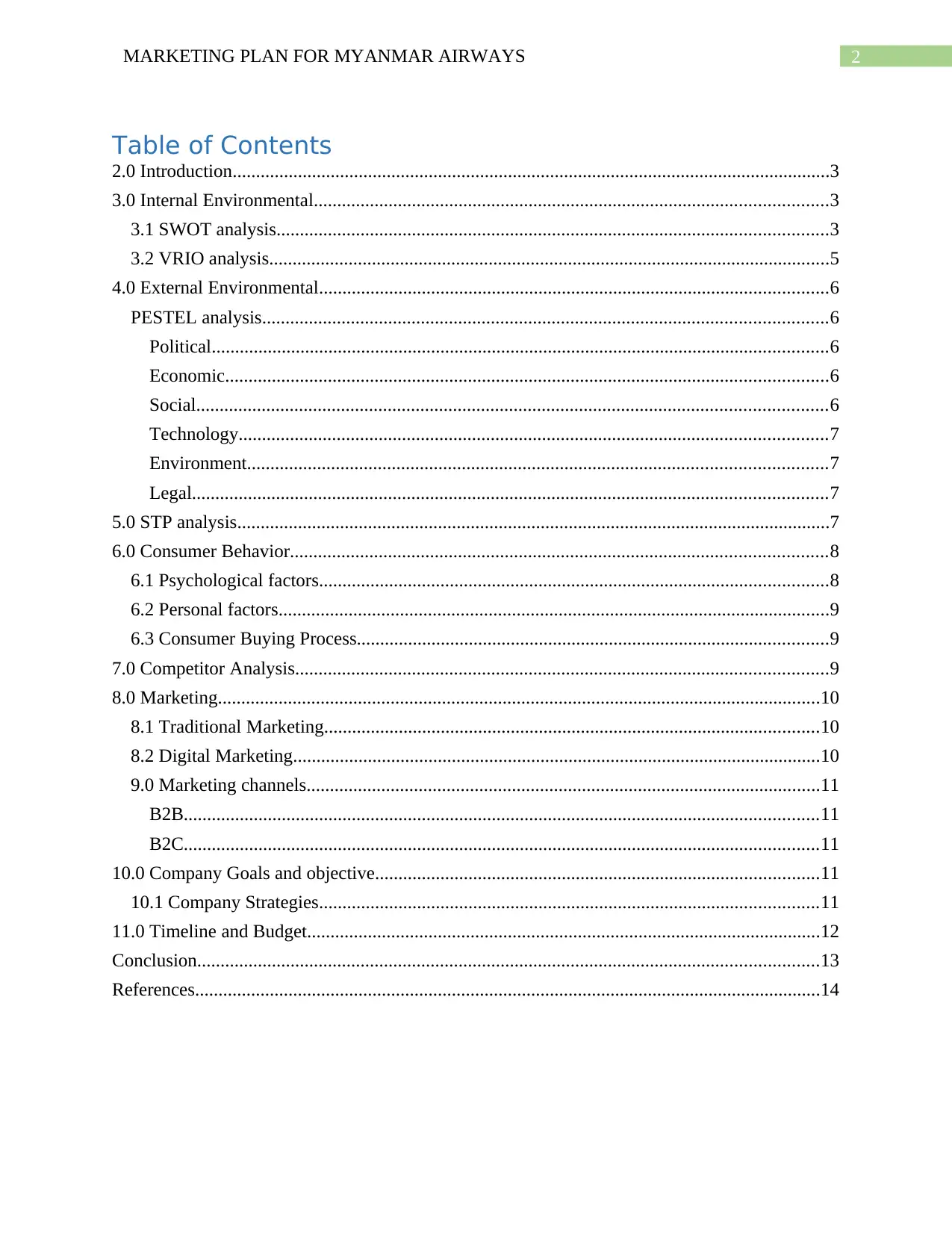
2MARKETING PLAN FOR MYANMAR AIRWAYS
Table of Contents
2.0 Introduction................................................................................................................................3
3.0 Internal Environmental..............................................................................................................3
3.1 SWOT analysis......................................................................................................................3
3.2 VRIO analysis........................................................................................................................5
4.0 External Environmental.............................................................................................................6
PESTEL analysis.........................................................................................................................6
Political....................................................................................................................................6
Economic.................................................................................................................................6
Social.......................................................................................................................................6
Technology..............................................................................................................................7
Environment............................................................................................................................7
Legal........................................................................................................................................7
5.0 STP analysis...............................................................................................................................7
6.0 Consumer Behavior...................................................................................................................8
6.1 Psychological factors.............................................................................................................8
6.2 Personal factors......................................................................................................................9
6.3 Consumer Buying Process.....................................................................................................9
7.0 Competitor Analysis..................................................................................................................9
8.0 Marketing.................................................................................................................................10
8.1 Traditional Marketing..........................................................................................................10
8.2 Digital Marketing.................................................................................................................10
9.0 Marketing channels..............................................................................................................11
B2B........................................................................................................................................11
B2C........................................................................................................................................11
10.0 Company Goals and objective...............................................................................................11
10.1 Company Strategies...........................................................................................................11
11.0 Timeline and Budget..............................................................................................................12
Conclusion.....................................................................................................................................13
References......................................................................................................................................14
Table of Contents
2.0 Introduction................................................................................................................................3
3.0 Internal Environmental..............................................................................................................3
3.1 SWOT analysis......................................................................................................................3
3.2 VRIO analysis........................................................................................................................5
4.0 External Environmental.............................................................................................................6
PESTEL analysis.........................................................................................................................6
Political....................................................................................................................................6
Economic.................................................................................................................................6
Social.......................................................................................................................................6
Technology..............................................................................................................................7
Environment............................................................................................................................7
Legal........................................................................................................................................7
5.0 STP analysis...............................................................................................................................7
6.0 Consumer Behavior...................................................................................................................8
6.1 Psychological factors.............................................................................................................8
6.2 Personal factors......................................................................................................................9
6.3 Consumer Buying Process.....................................................................................................9
7.0 Competitor Analysis..................................................................................................................9
8.0 Marketing.................................................................................................................................10
8.1 Traditional Marketing..........................................................................................................10
8.2 Digital Marketing.................................................................................................................10
9.0 Marketing channels..............................................................................................................11
B2B........................................................................................................................................11
B2C........................................................................................................................................11
10.0 Company Goals and objective...............................................................................................11
10.1 Company Strategies...........................................................................................................11
11.0 Timeline and Budget..............................................................................................................12
Conclusion.....................................................................................................................................13
References......................................................................................................................................14
⊘ This is a preview!⊘
Do you want full access?
Subscribe today to unlock all pages.

Trusted by 1+ million students worldwide
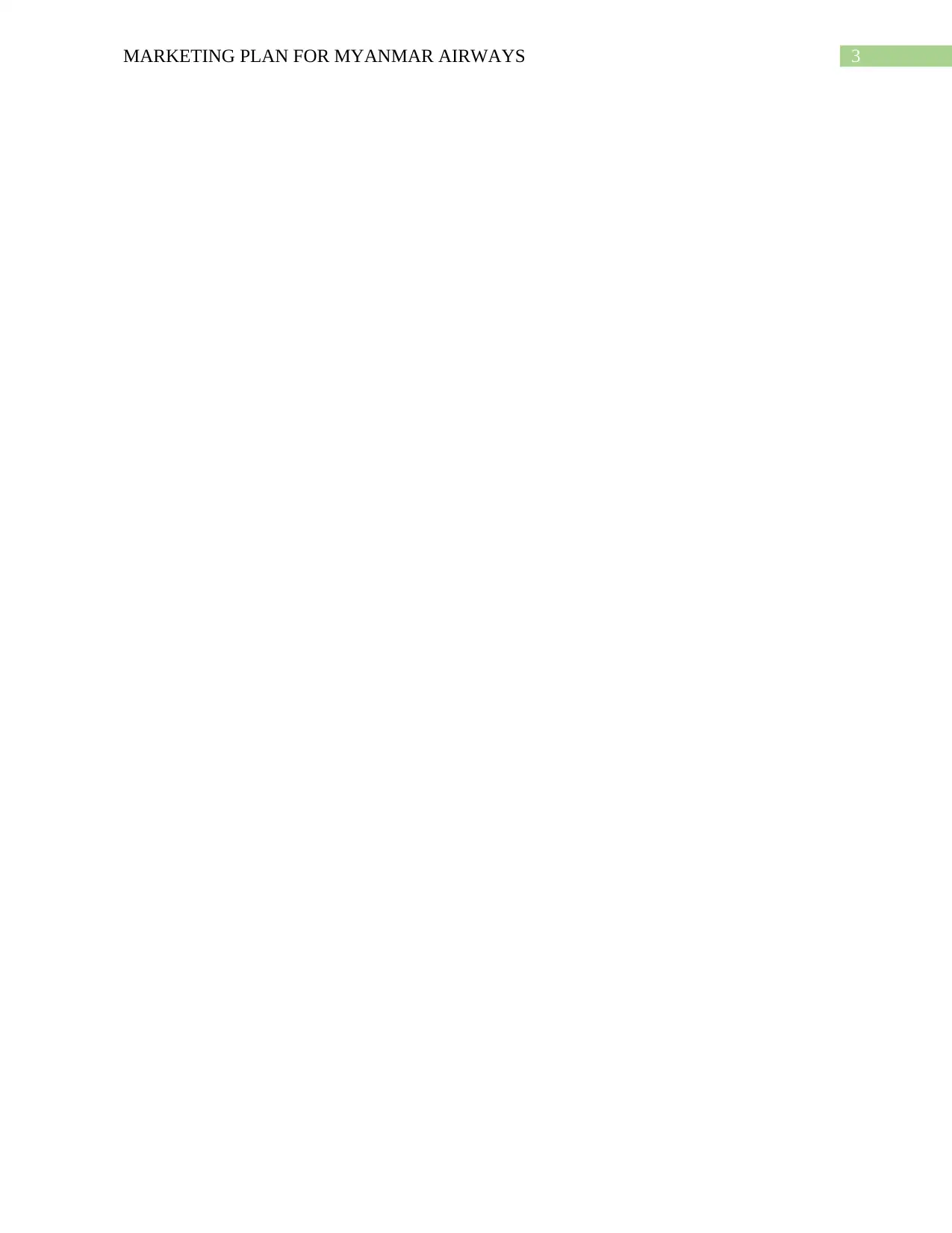
3MARKETING PLAN FOR MYANMAR AIRWAYS
Paraphrase This Document
Need a fresh take? Get an instant paraphrase of this document with our AI Paraphraser
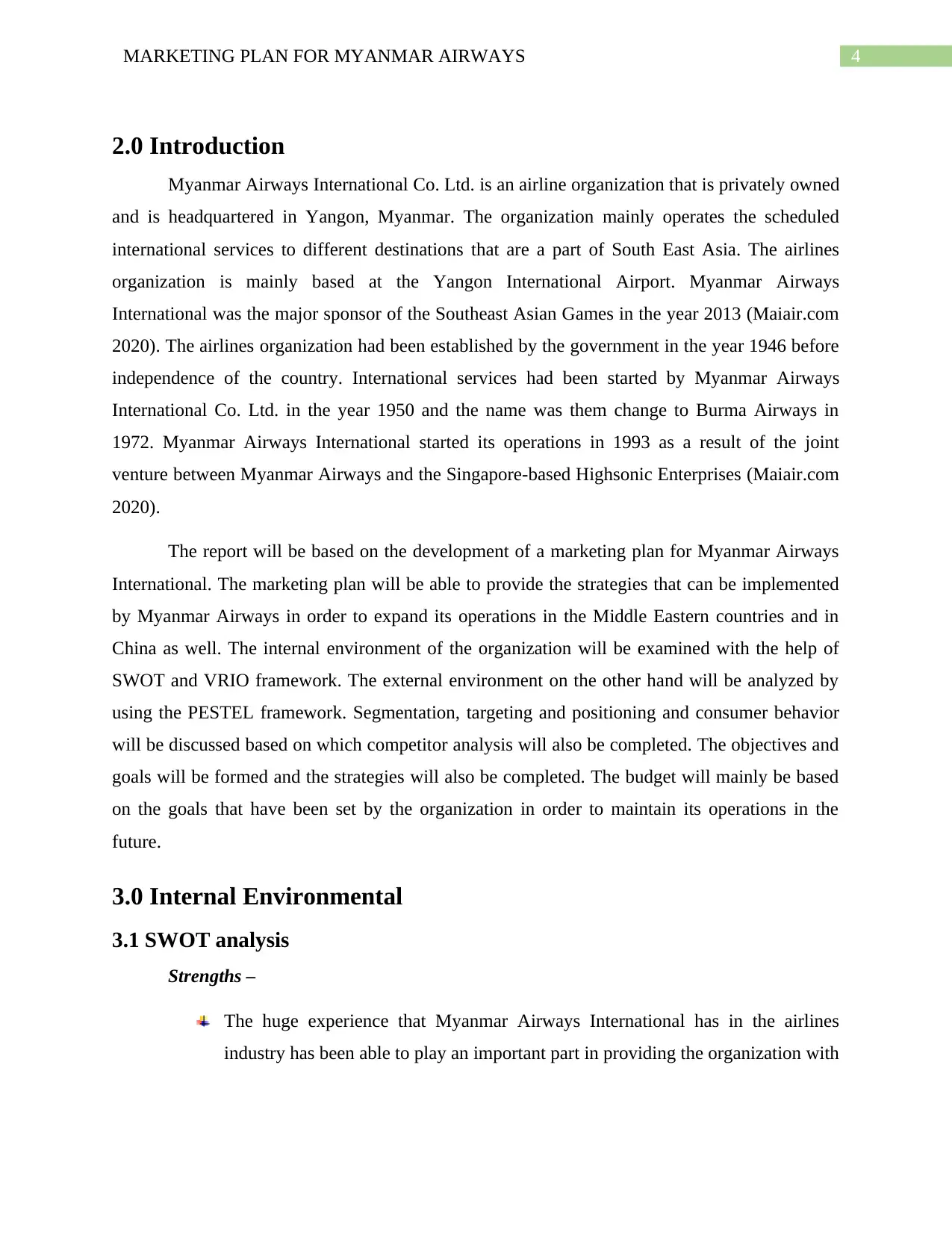
4MARKETING PLAN FOR MYANMAR AIRWAYS
2.0 Introduction
Myanmar Airways International Co. Ltd. is an airline organization that is privately owned
and is headquartered in Yangon, Myanmar. The organization mainly operates the scheduled
international services to different destinations that are a part of South East Asia. The airlines
organization is mainly based at the Yangon International Airport. Myanmar Airways
International was the major sponsor of the Southeast Asian Games in the year 2013 (Maiair.com
2020). The airlines organization had been established by the government in the year 1946 before
independence of the country. International services had been started by Myanmar Airways
International Co. Ltd. in the year 1950 and the name was them change to Burma Airways in
1972. Myanmar Airways International started its operations in 1993 as a result of the joint
venture between Myanmar Airways and the Singapore-based Highsonic Enterprises (Maiair.com
2020).
The report will be based on the development of a marketing plan for Myanmar Airways
International. The marketing plan will be able to provide the strategies that can be implemented
by Myanmar Airways in order to expand its operations in the Middle Eastern countries and in
China as well. The internal environment of the organization will be examined with the help of
SWOT and VRIO framework. The external environment on the other hand will be analyzed by
using the PESTEL framework. Segmentation, targeting and positioning and consumer behavior
will be discussed based on which competitor analysis will also be completed. The objectives and
goals will be formed and the strategies will also be completed. The budget will mainly be based
on the goals that have been set by the organization in order to maintain its operations in the
future.
3.0 Internal Environmental
3.1 SWOT analysis
Strengths –
The huge experience that Myanmar Airways International has in the airlines
industry has been able to play an important part in providing the organization with
2.0 Introduction
Myanmar Airways International Co. Ltd. is an airline organization that is privately owned
and is headquartered in Yangon, Myanmar. The organization mainly operates the scheduled
international services to different destinations that are a part of South East Asia. The airlines
organization is mainly based at the Yangon International Airport. Myanmar Airways
International was the major sponsor of the Southeast Asian Games in the year 2013 (Maiair.com
2020). The airlines organization had been established by the government in the year 1946 before
independence of the country. International services had been started by Myanmar Airways
International Co. Ltd. in the year 1950 and the name was them change to Burma Airways in
1972. Myanmar Airways International started its operations in 1993 as a result of the joint
venture between Myanmar Airways and the Singapore-based Highsonic Enterprises (Maiair.com
2020).
The report will be based on the development of a marketing plan for Myanmar Airways
International. The marketing plan will be able to provide the strategies that can be implemented
by Myanmar Airways in order to expand its operations in the Middle Eastern countries and in
China as well. The internal environment of the organization will be examined with the help of
SWOT and VRIO framework. The external environment on the other hand will be analyzed by
using the PESTEL framework. Segmentation, targeting and positioning and consumer behavior
will be discussed based on which competitor analysis will also be completed. The objectives and
goals will be formed and the strategies will also be completed. The budget will mainly be based
on the goals that have been set by the organization in order to maintain its operations in the
future.
3.0 Internal Environmental
3.1 SWOT analysis
Strengths –
The huge experience that Myanmar Airways International has in the airlines
industry has been able to play an important part in providing the organization with
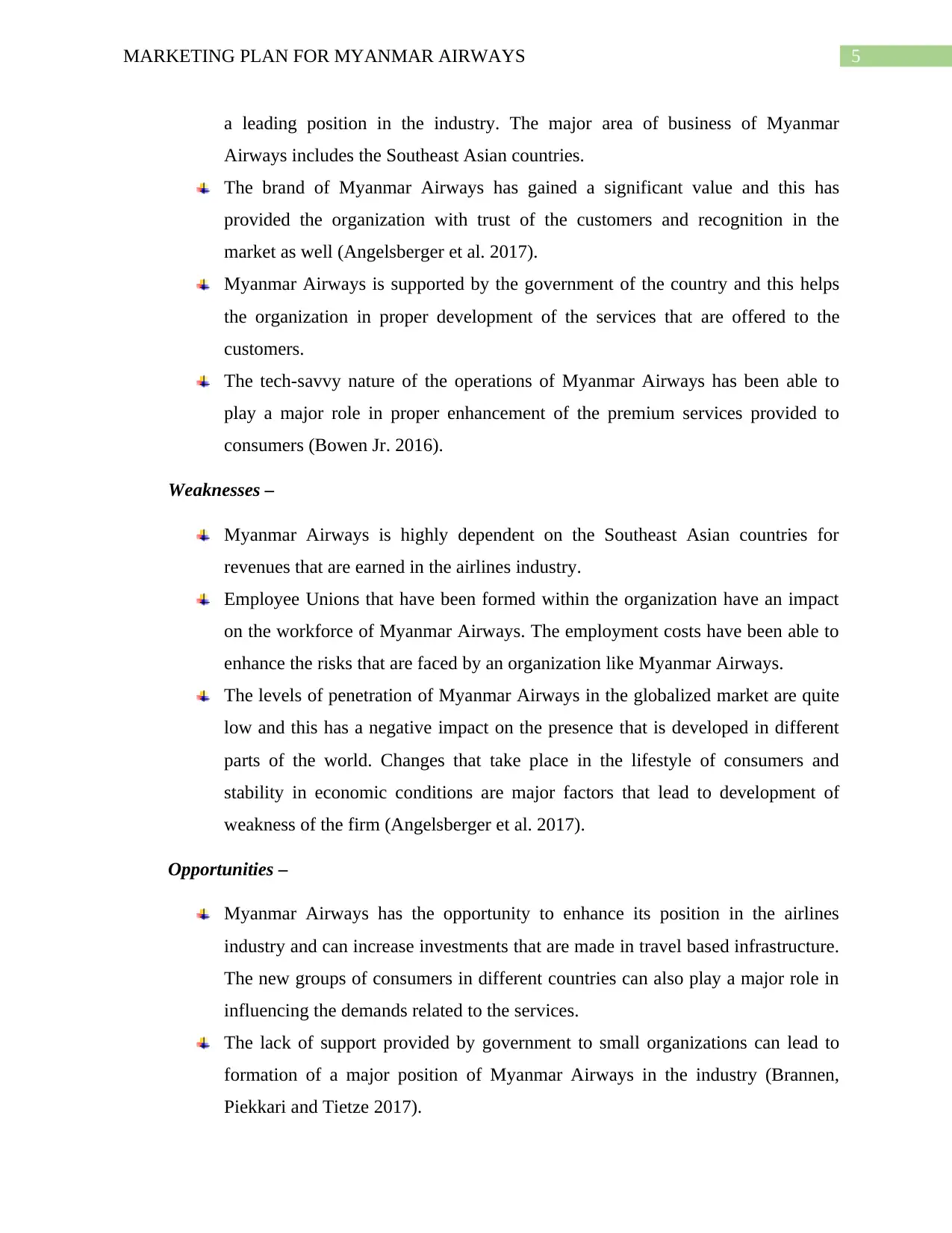
5MARKETING PLAN FOR MYANMAR AIRWAYS
a leading position in the industry. The major area of business of Myanmar
Airways includes the Southeast Asian countries.
The brand of Myanmar Airways has gained a significant value and this has
provided the organization with trust of the customers and recognition in the
market as well (Angelsberger et al. 2017).
Myanmar Airways is supported by the government of the country and this helps
the organization in proper development of the services that are offered to the
customers.
The tech-savvy nature of the operations of Myanmar Airways has been able to
play a major role in proper enhancement of the premium services provided to
consumers (Bowen Jr. 2016).
Weaknesses –
Myanmar Airways is highly dependent on the Southeast Asian countries for
revenues that are earned in the airlines industry.
Employee Unions that have been formed within the organization have an impact
on the workforce of Myanmar Airways. The employment costs have been able to
enhance the risks that are faced by an organization like Myanmar Airways.
The levels of penetration of Myanmar Airways in the globalized market are quite
low and this has a negative impact on the presence that is developed in different
parts of the world. Changes that take place in the lifestyle of consumers and
stability in economic conditions are major factors that lead to development of
weakness of the firm (Angelsberger et al. 2017).
Opportunities –
Myanmar Airways has the opportunity to enhance its position in the airlines
industry and can increase investments that are made in travel based infrastructure.
The new groups of consumers in different countries can also play a major role in
influencing the demands related to the services.
The lack of support provided by government to small organizations can lead to
formation of a major position of Myanmar Airways in the industry (Brannen,
Piekkari and Tietze 2017).
a leading position in the industry. The major area of business of Myanmar
Airways includes the Southeast Asian countries.
The brand of Myanmar Airways has gained a significant value and this has
provided the organization with trust of the customers and recognition in the
market as well (Angelsberger et al. 2017).
Myanmar Airways is supported by the government of the country and this helps
the organization in proper development of the services that are offered to the
customers.
The tech-savvy nature of the operations of Myanmar Airways has been able to
play a major role in proper enhancement of the premium services provided to
consumers (Bowen Jr. 2016).
Weaknesses –
Myanmar Airways is highly dependent on the Southeast Asian countries for
revenues that are earned in the airlines industry.
Employee Unions that have been formed within the organization have an impact
on the workforce of Myanmar Airways. The employment costs have been able to
enhance the risks that are faced by an organization like Myanmar Airways.
The levels of penetration of Myanmar Airways in the globalized market are quite
low and this has a negative impact on the presence that is developed in different
parts of the world. Changes that take place in the lifestyle of consumers and
stability in economic conditions are major factors that lead to development of
weakness of the firm (Angelsberger et al. 2017).
Opportunities –
Myanmar Airways has the opportunity to enhance its position in the airlines
industry and can increase investments that are made in travel based infrastructure.
The new groups of consumers in different countries can also play a major role in
influencing the demands related to the services.
The lack of support provided by government to small organizations can lead to
formation of a major position of Myanmar Airways in the industry (Brannen,
Piekkari and Tietze 2017).
⊘ This is a preview!⊘
Do you want full access?
Subscribe today to unlock all pages.

Trusted by 1+ million students worldwide
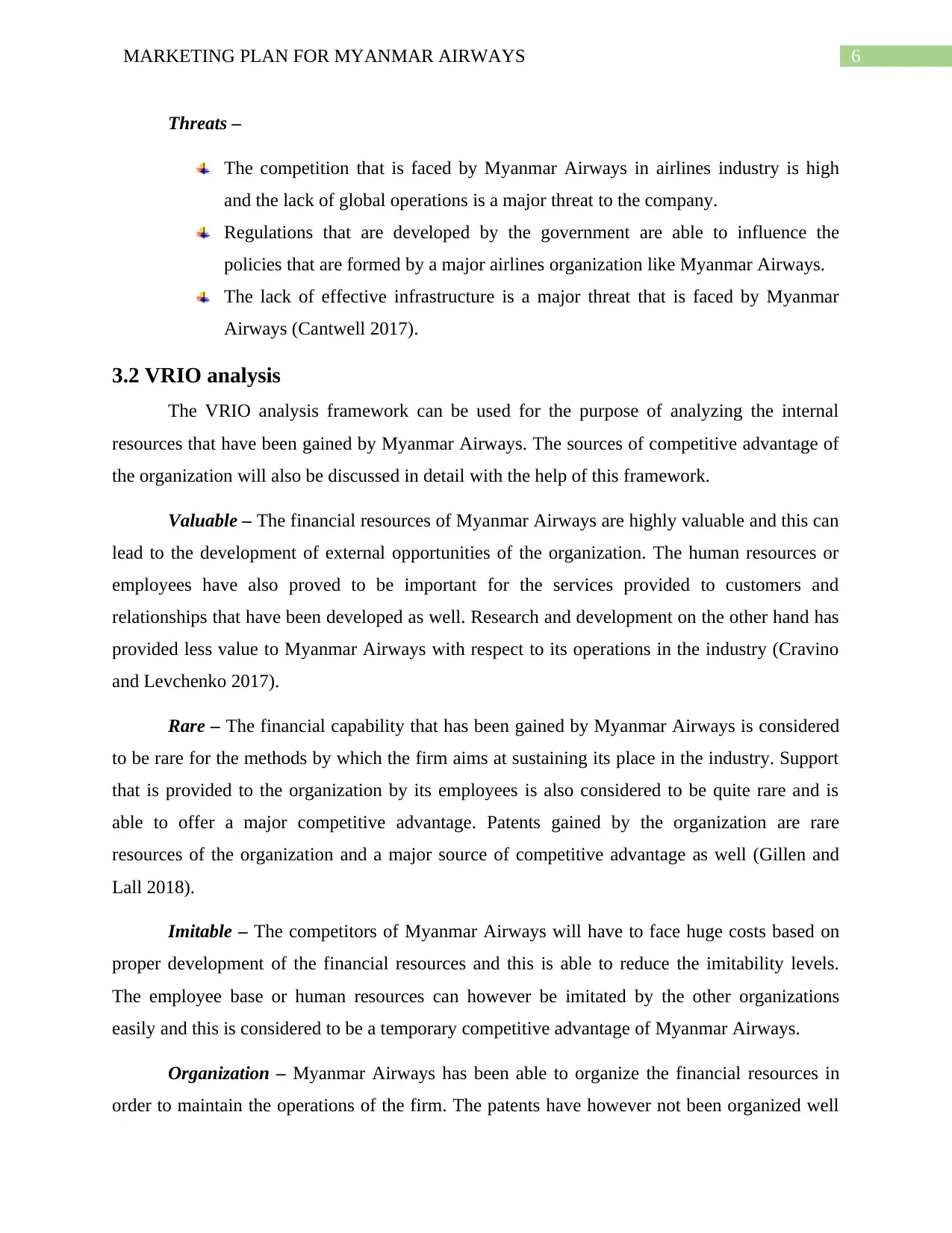
6MARKETING PLAN FOR MYANMAR AIRWAYS
Threats –
The competition that is faced by Myanmar Airways in airlines industry is high
and the lack of global operations is a major threat to the company.
Regulations that are developed by the government are able to influence the
policies that are formed by a major airlines organization like Myanmar Airways.
The lack of effective infrastructure is a major threat that is faced by Myanmar
Airways (Cantwell 2017).
3.2 VRIO analysis
The VRIO analysis framework can be used for the purpose of analyzing the internal
resources that have been gained by Myanmar Airways. The sources of competitive advantage of
the organization will also be discussed in detail with the help of this framework.
Valuable – The financial resources of Myanmar Airways are highly valuable and this can
lead to the development of external opportunities of the organization. The human resources or
employees have also proved to be important for the services provided to customers and
relationships that have been developed as well. Research and development on the other hand has
provided less value to Myanmar Airways with respect to its operations in the industry (Cravino
and Levchenko 2017).
Rare – The financial capability that has been gained by Myanmar Airways is considered
to be rare for the methods by which the firm aims at sustaining its place in the industry. Support
that is provided to the organization by its employees is also considered to be quite rare and is
able to offer a major competitive advantage. Patents gained by the organization are rare
resources of the organization and a major source of competitive advantage as well (Gillen and
Lall 2018).
Imitable – The competitors of Myanmar Airways will have to face huge costs based on
proper development of the financial resources and this is able to reduce the imitability levels.
The employee base or human resources can however be imitated by the other organizations
easily and this is considered to be a temporary competitive advantage of Myanmar Airways.
Organization – Myanmar Airways has been able to organize the financial resources in
order to maintain the operations of the firm. The patents have however not been organized well
Threats –
The competition that is faced by Myanmar Airways in airlines industry is high
and the lack of global operations is a major threat to the company.
Regulations that are developed by the government are able to influence the
policies that are formed by a major airlines organization like Myanmar Airways.
The lack of effective infrastructure is a major threat that is faced by Myanmar
Airways (Cantwell 2017).
3.2 VRIO analysis
The VRIO analysis framework can be used for the purpose of analyzing the internal
resources that have been gained by Myanmar Airways. The sources of competitive advantage of
the organization will also be discussed in detail with the help of this framework.
Valuable – The financial resources of Myanmar Airways are highly valuable and this can
lead to the development of external opportunities of the organization. The human resources or
employees have also proved to be important for the services provided to customers and
relationships that have been developed as well. Research and development on the other hand has
provided less value to Myanmar Airways with respect to its operations in the industry (Cravino
and Levchenko 2017).
Rare – The financial capability that has been gained by Myanmar Airways is considered
to be rare for the methods by which the firm aims at sustaining its place in the industry. Support
that is provided to the organization by its employees is also considered to be quite rare and is
able to offer a major competitive advantage. Patents gained by the organization are rare
resources of the organization and a major source of competitive advantage as well (Gillen and
Lall 2018).
Imitable – The competitors of Myanmar Airways will have to face huge costs based on
proper development of the financial resources and this is able to reduce the imitability levels.
The employee base or human resources can however be imitated by the other organizations
easily and this is considered to be a temporary competitive advantage of Myanmar Airways.
Organization – Myanmar Airways has been able to organize the financial resources in
order to maintain the operations of the firm. The patents have however not been organized well
Paraphrase This Document
Need a fresh take? Get an instant paraphrase of this document with our AI Paraphraser
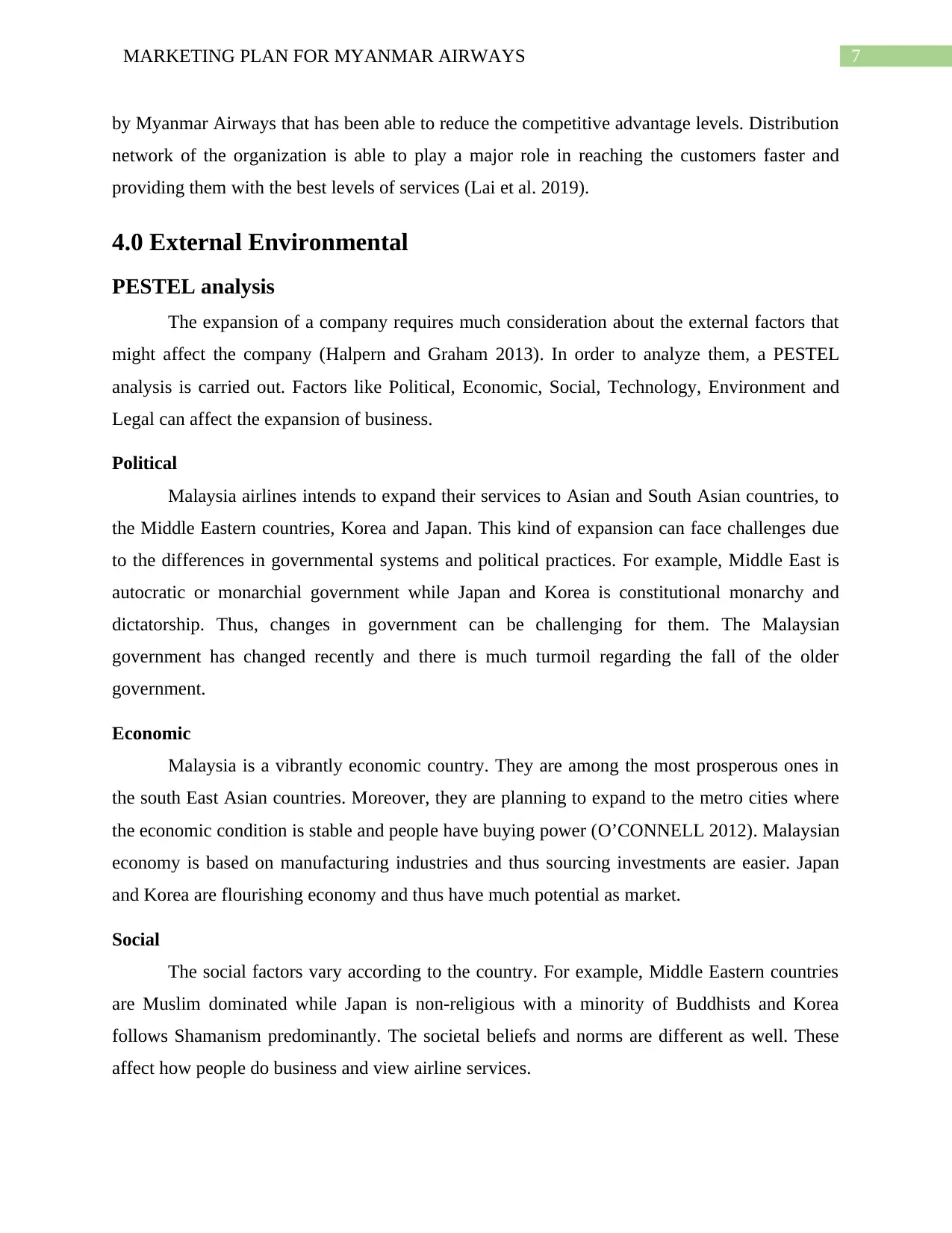
7MARKETING PLAN FOR MYANMAR AIRWAYS
by Myanmar Airways that has been able to reduce the competitive advantage levels. Distribution
network of the organization is able to play a major role in reaching the customers faster and
providing them with the best levels of services (Lai et al. 2019).
4.0 External Environmental
PESTEL analysis
The expansion of a company requires much consideration about the external factors that
might affect the company (Halpern and Graham 2013). In order to analyze them, a PESTEL
analysis is carried out. Factors like Political, Economic, Social, Technology, Environment and
Legal can affect the expansion of business.
Political
Malaysia airlines intends to expand their services to Asian and South Asian countries, to
the Middle Eastern countries, Korea and Japan. This kind of expansion can face challenges due
to the differences in governmental systems and political practices. For example, Middle East is
autocratic or monarchial government while Japan and Korea is constitutional monarchy and
dictatorship. Thus, changes in government can be challenging for them. The Malaysian
government has changed recently and there is much turmoil regarding the fall of the older
government.
Economic
Malaysia is a vibrantly economic country. They are among the most prosperous ones in
the south East Asian countries. Moreover, they are planning to expand to the metro cities where
the economic condition is stable and people have buying power (O’CONNELL 2012). Malaysian
economy is based on manufacturing industries and thus sourcing investments are easier. Japan
and Korea are flourishing economy and thus have much potential as market.
Social
The social factors vary according to the country. For example, Middle Eastern countries
are Muslim dominated while Japan is non-religious with a minority of Buddhists and Korea
follows Shamanism predominantly. The societal beliefs and norms are different as well. These
affect how people do business and view airline services.
by Myanmar Airways that has been able to reduce the competitive advantage levels. Distribution
network of the organization is able to play a major role in reaching the customers faster and
providing them with the best levels of services (Lai et al. 2019).
4.0 External Environmental
PESTEL analysis
The expansion of a company requires much consideration about the external factors that
might affect the company (Halpern and Graham 2013). In order to analyze them, a PESTEL
analysis is carried out. Factors like Political, Economic, Social, Technology, Environment and
Legal can affect the expansion of business.
Political
Malaysia airlines intends to expand their services to Asian and South Asian countries, to
the Middle Eastern countries, Korea and Japan. This kind of expansion can face challenges due
to the differences in governmental systems and political practices. For example, Middle East is
autocratic or monarchial government while Japan and Korea is constitutional monarchy and
dictatorship. Thus, changes in government can be challenging for them. The Malaysian
government has changed recently and there is much turmoil regarding the fall of the older
government.
Economic
Malaysia is a vibrantly economic country. They are among the most prosperous ones in
the south East Asian countries. Moreover, they are planning to expand to the metro cities where
the economic condition is stable and people have buying power (O’CONNELL 2012). Malaysian
economy is based on manufacturing industries and thus sourcing investments are easier. Japan
and Korea are flourishing economy and thus have much potential as market.
Social
The social factors vary according to the country. For example, Middle Eastern countries
are Muslim dominated while Japan is non-religious with a minority of Buddhists and Korea
follows Shamanism predominantly. The societal beliefs and norms are different as well. These
affect how people do business and view airline services.
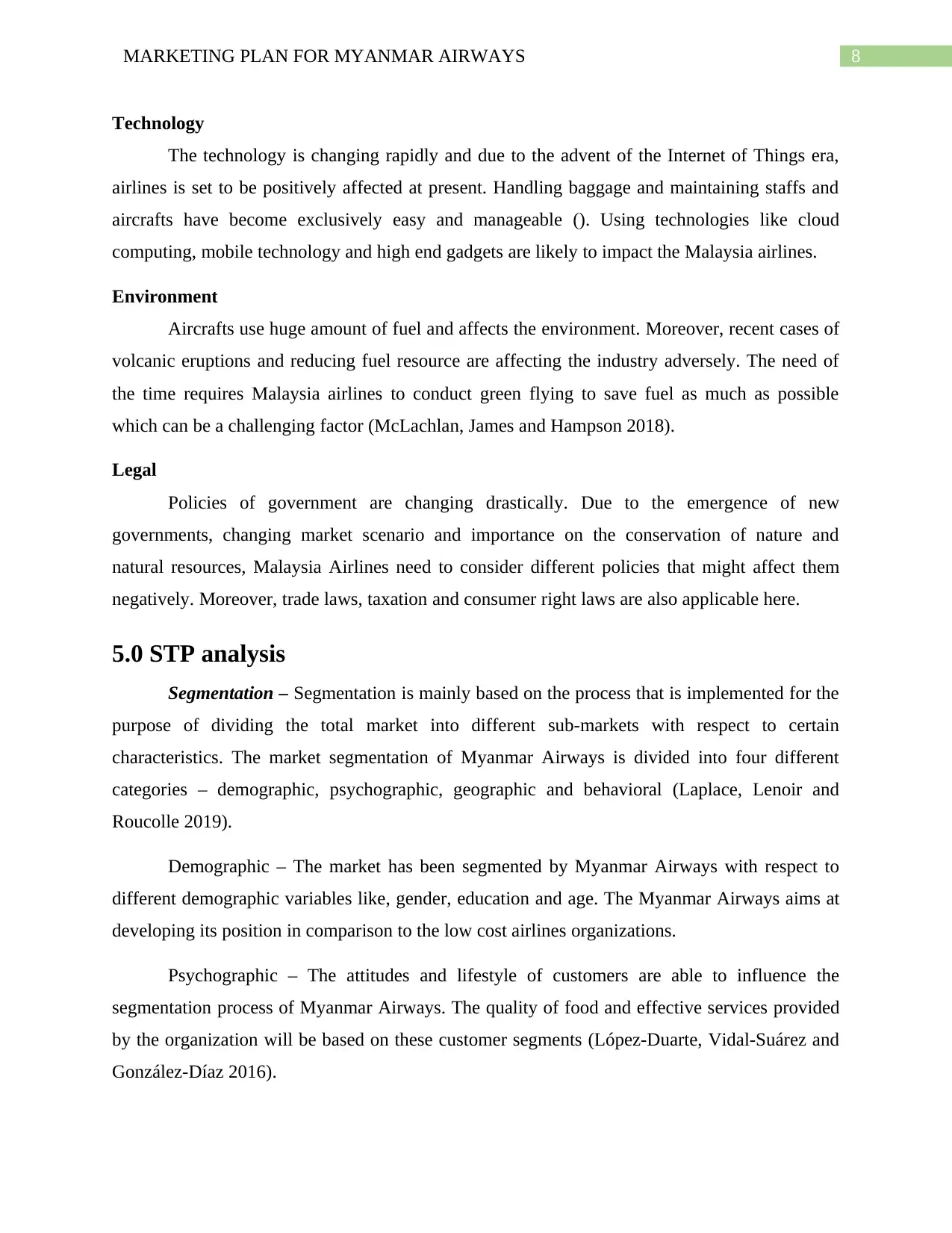
8MARKETING PLAN FOR MYANMAR AIRWAYS
Technology
The technology is changing rapidly and due to the advent of the Internet of Things era,
airlines is set to be positively affected at present. Handling baggage and maintaining staffs and
aircrafts have become exclusively easy and manageable (). Using technologies like cloud
computing, mobile technology and high end gadgets are likely to impact the Malaysia airlines.
Environment
Aircrafts use huge amount of fuel and affects the environment. Moreover, recent cases of
volcanic eruptions and reducing fuel resource are affecting the industry adversely. The need of
the time requires Malaysia airlines to conduct green flying to save fuel as much as possible
which can be a challenging factor (McLachlan, James and Hampson 2018).
Legal
Policies of government are changing drastically. Due to the emergence of new
governments, changing market scenario and importance on the conservation of nature and
natural resources, Malaysia Airlines need to consider different policies that might affect them
negatively. Moreover, trade laws, taxation and consumer right laws are also applicable here.
5.0 STP analysis
Segmentation – Segmentation is mainly based on the process that is implemented for the
purpose of dividing the total market into different sub-markets with respect to certain
characteristics. The market segmentation of Myanmar Airways is divided into four different
categories – demographic, psychographic, geographic and behavioral (Laplace, Lenoir and
Roucolle 2019).
Demographic – The market has been segmented by Myanmar Airways with respect to
different demographic variables like, gender, education and age. The Myanmar Airways aims at
developing its position in comparison to the low cost airlines organizations.
Psychographic – The attitudes and lifestyle of customers are able to influence the
segmentation process of Myanmar Airways. The quality of food and effective services provided
by the organization will be based on these customer segments (López‐Duarte, Vidal‐Suárez and
González‐Díaz 2016).
Technology
The technology is changing rapidly and due to the advent of the Internet of Things era,
airlines is set to be positively affected at present. Handling baggage and maintaining staffs and
aircrafts have become exclusively easy and manageable (). Using technologies like cloud
computing, mobile technology and high end gadgets are likely to impact the Malaysia airlines.
Environment
Aircrafts use huge amount of fuel and affects the environment. Moreover, recent cases of
volcanic eruptions and reducing fuel resource are affecting the industry adversely. The need of
the time requires Malaysia airlines to conduct green flying to save fuel as much as possible
which can be a challenging factor (McLachlan, James and Hampson 2018).
Legal
Policies of government are changing drastically. Due to the emergence of new
governments, changing market scenario and importance on the conservation of nature and
natural resources, Malaysia Airlines need to consider different policies that might affect them
negatively. Moreover, trade laws, taxation and consumer right laws are also applicable here.
5.0 STP analysis
Segmentation – Segmentation is mainly based on the process that is implemented for the
purpose of dividing the total market into different sub-markets with respect to certain
characteristics. The market segmentation of Myanmar Airways is divided into four different
categories – demographic, psychographic, geographic and behavioral (Laplace, Lenoir and
Roucolle 2019).
Demographic – The market has been segmented by Myanmar Airways with respect to
different demographic variables like, gender, education and age. The Myanmar Airways aims at
developing its position in comparison to the low cost airlines organizations.
Psychographic – The attitudes and lifestyle of customers are able to influence the
segmentation process of Myanmar Airways. The quality of food and effective services provided
by the organization will be based on these customer segments (López‐Duarte, Vidal‐Suárez and
González‐Díaz 2016).
⊘ This is a preview!⊘
Do you want full access?
Subscribe today to unlock all pages.

Trusted by 1+ million students worldwide
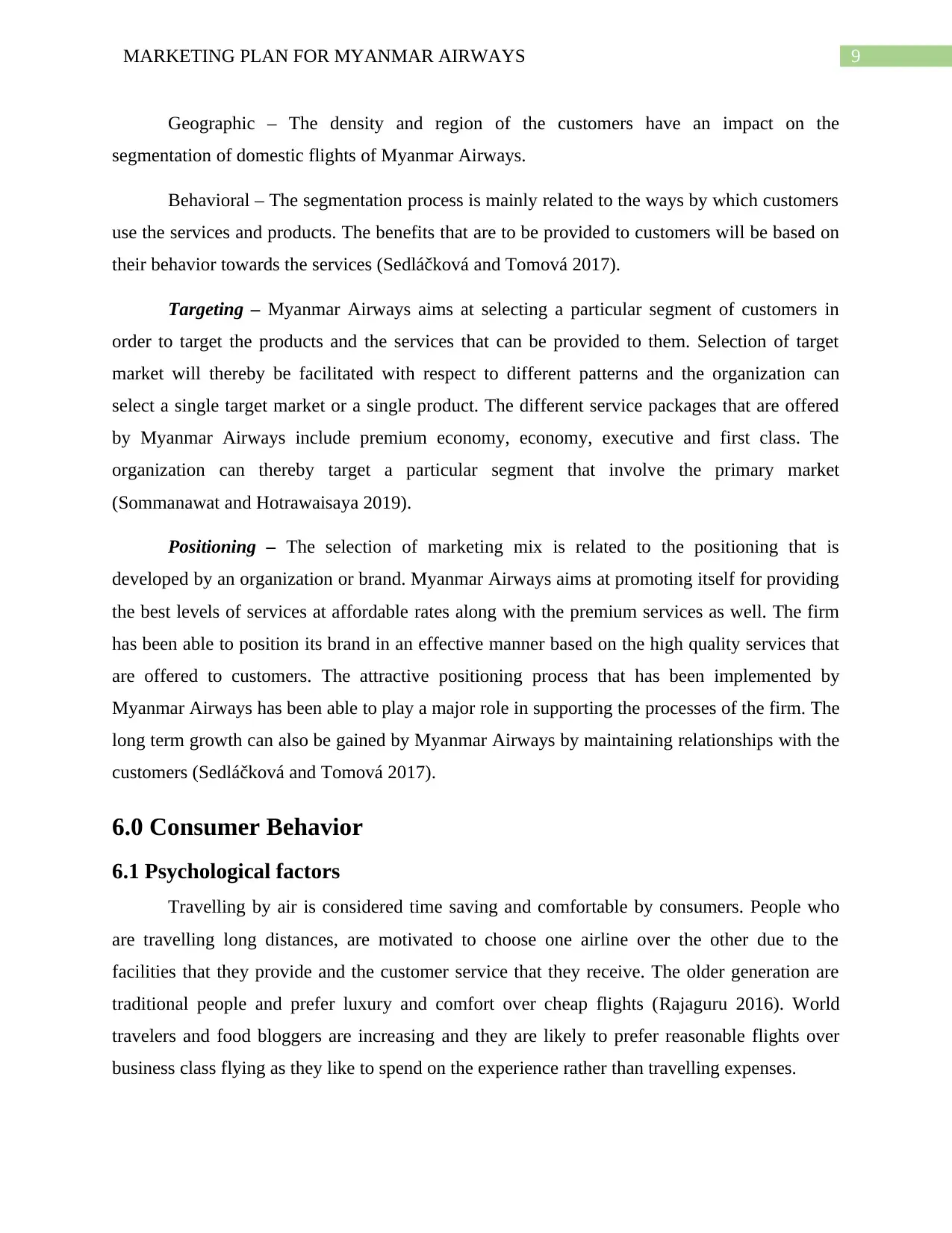
9MARKETING PLAN FOR MYANMAR AIRWAYS
Geographic – The density and region of the customers have an impact on the
segmentation of domestic flights of Myanmar Airways.
Behavioral – The segmentation process is mainly related to the ways by which customers
use the services and products. The benefits that are to be provided to customers will be based on
their behavior towards the services (Sedláčková and Tomová 2017).
Targeting – Myanmar Airways aims at selecting a particular segment of customers in
order to target the products and the services that can be provided to them. Selection of target
market will thereby be facilitated with respect to different patterns and the organization can
select a single target market or a single product. The different service packages that are offered
by Myanmar Airways include premium economy, economy, executive and first class. The
organization can thereby target a particular segment that involve the primary market
(Sommanawat and Hotrawaisaya 2019).
Positioning – The selection of marketing mix is related to the positioning that is
developed by an organization or brand. Myanmar Airways aims at promoting itself for providing
the best levels of services at affordable rates along with the premium services as well. The firm
has been able to position its brand in an effective manner based on the high quality services that
are offered to customers. The attractive positioning process that has been implemented by
Myanmar Airways has been able to play a major role in supporting the processes of the firm. The
long term growth can also be gained by Myanmar Airways by maintaining relationships with the
customers (Sedláčková and Tomová 2017).
6.0 Consumer Behavior
6.1 Psychological factors
Travelling by air is considered time saving and comfortable by consumers. People who
are travelling long distances, are motivated to choose one airline over the other due to the
facilities that they provide and the customer service that they receive. The older generation are
traditional people and prefer luxury and comfort over cheap flights (Rajaguru 2016). World
travelers and food bloggers are increasing and they are likely to prefer reasonable flights over
business class flying as they like to spend on the experience rather than travelling expenses.
Geographic – The density and region of the customers have an impact on the
segmentation of domestic flights of Myanmar Airways.
Behavioral – The segmentation process is mainly related to the ways by which customers
use the services and products. The benefits that are to be provided to customers will be based on
their behavior towards the services (Sedláčková and Tomová 2017).
Targeting – Myanmar Airways aims at selecting a particular segment of customers in
order to target the products and the services that can be provided to them. Selection of target
market will thereby be facilitated with respect to different patterns and the organization can
select a single target market or a single product. The different service packages that are offered
by Myanmar Airways include premium economy, economy, executive and first class. The
organization can thereby target a particular segment that involve the primary market
(Sommanawat and Hotrawaisaya 2019).
Positioning – The selection of marketing mix is related to the positioning that is
developed by an organization or brand. Myanmar Airways aims at promoting itself for providing
the best levels of services at affordable rates along with the premium services as well. The firm
has been able to position its brand in an effective manner based on the high quality services that
are offered to customers. The attractive positioning process that has been implemented by
Myanmar Airways has been able to play a major role in supporting the processes of the firm. The
long term growth can also be gained by Myanmar Airways by maintaining relationships with the
customers (Sedláčková and Tomová 2017).
6.0 Consumer Behavior
6.1 Psychological factors
Travelling by air is considered time saving and comfortable by consumers. People who
are travelling long distances, are motivated to choose one airline over the other due to the
facilities that they provide and the customer service that they receive. The older generation are
traditional people and prefer luxury and comfort over cheap flights (Rajaguru 2016). World
travelers and food bloggers are increasing and they are likely to prefer reasonable flights over
business class flying as they like to spend on the experience rather than travelling expenses.
Paraphrase This Document
Need a fresh take? Get an instant paraphrase of this document with our AI Paraphraser

10MARKETING PLAN FOR MYANMAR AIRWAYS
6.2 Personal factors
Personal factors are important driving factors for consumers. Factors like their conception
of self, the need to express and explore are much higher with the baby boomer and the generation
Z (Murugan 2017). These people believe in saving time and thus are likely to travel more by
flights. There are also sentimental factors like shopping in the trade free shops or other facilities
that people like which drive them to avail services of airlines. Changing lifestyle is also affecting
the consumer decision making. At present, the younger generation travel for their jobs and
studies. The countries that Malaysia airlines have targeted are places from where people travel to
Europe and USA for further studies and the baby boomers, the parent generation are also likely
to travel for reuniting with family.
6.3 Consumer Buying Process
The advancement of technology and availability of information has given the customers
the ability to make an important decision. Passengers prefer airlines that have high reviews and
better facilities. Factors like flight punctuality, cleanliness, staffs, seating arrangement and
entertainment are important factors of consumer buying process (Addepalli et al. 2018). The
consumers gather information about the available airlines flying to their routes, tally the
information keeping in mind those factors and compare prices accordingly. Consumers are also
likely to prefer flights that have lesser layover time.
7.0 Competitor Analysis
Air KBZ is the major competitor of Myanmar Airways and has been able to gain second
place in the market. The competition on domestic market has started increasing due to the start of
operations of Air Mandalay. The new organizations like FMI Air and Apex Airlines have also
been able to play a key part in enhancing the competitive environment in the country. The
intensifying competition in airlines industry has been able to affect the revenues and profitability
that is gained by Myanmar Airways in the industry. The services that are provided by
organizations like Air KBZ are considered to be quite similar to that of Myanmar Airways
(Sommanawat and Hotrawaisaya 2019).
The social media integration of Myanmar Airways is however better than that of its major
competitor Air KBZ. The increased competitiveness of airlines industry of Myanmar is
6.2 Personal factors
Personal factors are important driving factors for consumers. Factors like their conception
of self, the need to express and explore are much higher with the baby boomer and the generation
Z (Murugan 2017). These people believe in saving time and thus are likely to travel more by
flights. There are also sentimental factors like shopping in the trade free shops or other facilities
that people like which drive them to avail services of airlines. Changing lifestyle is also affecting
the consumer decision making. At present, the younger generation travel for their jobs and
studies. The countries that Malaysia airlines have targeted are places from where people travel to
Europe and USA for further studies and the baby boomers, the parent generation are also likely
to travel for reuniting with family.
6.3 Consumer Buying Process
The advancement of technology and availability of information has given the customers
the ability to make an important decision. Passengers prefer airlines that have high reviews and
better facilities. Factors like flight punctuality, cleanliness, staffs, seating arrangement and
entertainment are important factors of consumer buying process (Addepalli et al. 2018). The
consumers gather information about the available airlines flying to their routes, tally the
information keeping in mind those factors and compare prices accordingly. Consumers are also
likely to prefer flights that have lesser layover time.
7.0 Competitor Analysis
Air KBZ is the major competitor of Myanmar Airways and has been able to gain second
place in the market. The competition on domestic market has started increasing due to the start of
operations of Air Mandalay. The new organizations like FMI Air and Apex Airlines have also
been able to play a key part in enhancing the competitive environment in the country. The
intensifying competition in airlines industry has been able to affect the revenues and profitability
that is gained by Myanmar Airways in the industry. The services that are provided by
organizations like Air KBZ are considered to be quite similar to that of Myanmar Airways
(Sommanawat and Hotrawaisaya 2019).
The social media integration of Myanmar Airways is however better than that of its major
competitor Air KBZ. The increased competitiveness of airlines industry of Myanmar is
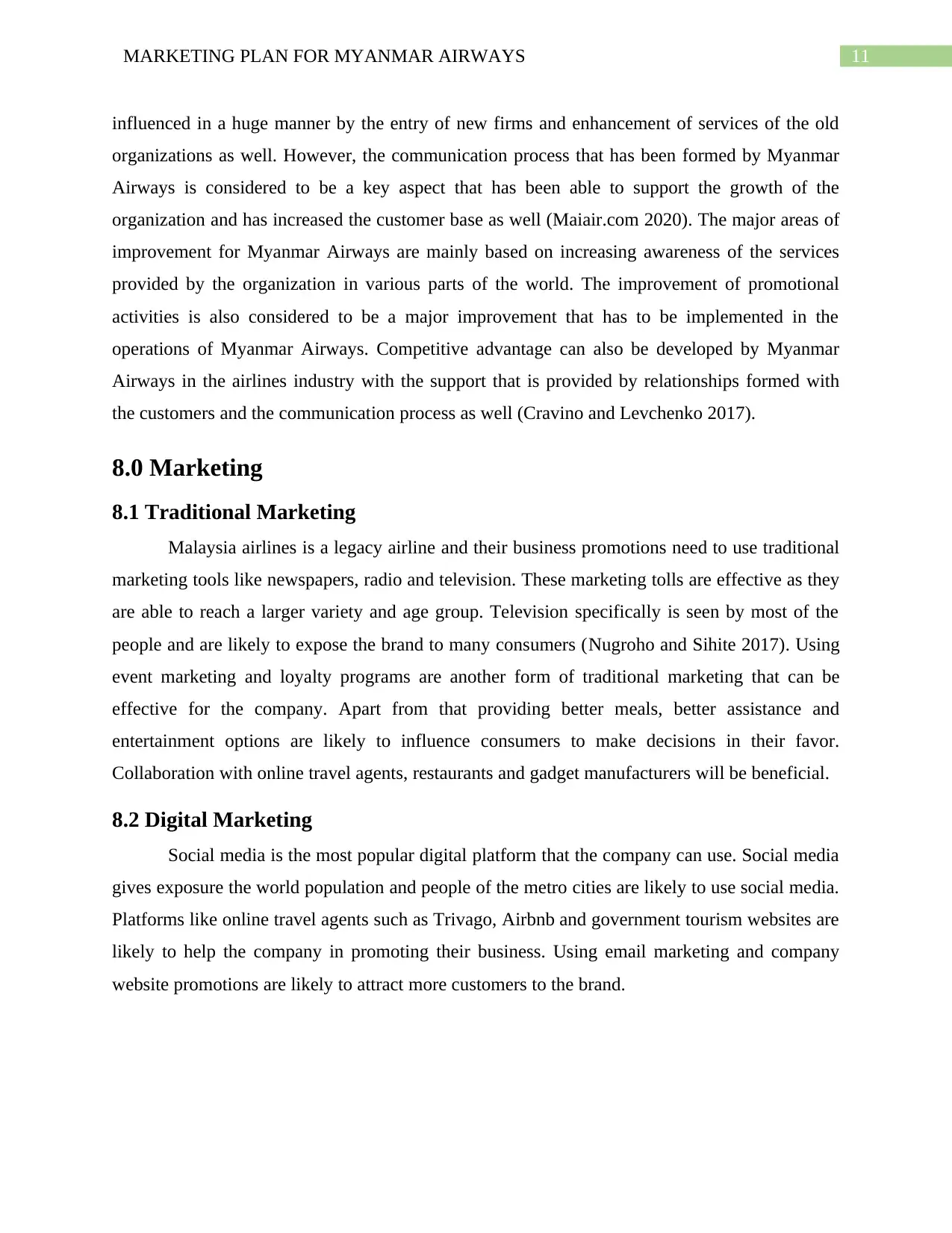
11MARKETING PLAN FOR MYANMAR AIRWAYS
influenced in a huge manner by the entry of new firms and enhancement of services of the old
organizations as well. However, the communication process that has been formed by Myanmar
Airways is considered to be a key aspect that has been able to support the growth of the
organization and has increased the customer base as well (Maiair.com 2020). The major areas of
improvement for Myanmar Airways are mainly based on increasing awareness of the services
provided by the organization in various parts of the world. The improvement of promotional
activities is also considered to be a major improvement that has to be implemented in the
operations of Myanmar Airways. Competitive advantage can also be developed by Myanmar
Airways in the airlines industry with the support that is provided by relationships formed with
the customers and the communication process as well (Cravino and Levchenko 2017).
8.0 Marketing
8.1 Traditional Marketing
Malaysia airlines is a legacy airline and their business promotions need to use traditional
marketing tools like newspapers, radio and television. These marketing tolls are effective as they
are able to reach a larger variety and age group. Television specifically is seen by most of the
people and are likely to expose the brand to many consumers (Nugroho and Sihite 2017). Using
event marketing and loyalty programs are another form of traditional marketing that can be
effective for the company. Apart from that providing better meals, better assistance and
entertainment options are likely to influence consumers to make decisions in their favor.
Collaboration with online travel agents, restaurants and gadget manufacturers will be beneficial.
8.2 Digital Marketing
Social media is the most popular digital platform that the company can use. Social media
gives exposure the world population and people of the metro cities are likely to use social media.
Platforms like online travel agents such as Trivago, Airbnb and government tourism websites are
likely to help the company in promoting their business. Using email marketing and company
website promotions are likely to attract more customers to the brand.
influenced in a huge manner by the entry of new firms and enhancement of services of the old
organizations as well. However, the communication process that has been formed by Myanmar
Airways is considered to be a key aspect that has been able to support the growth of the
organization and has increased the customer base as well (Maiair.com 2020). The major areas of
improvement for Myanmar Airways are mainly based on increasing awareness of the services
provided by the organization in various parts of the world. The improvement of promotional
activities is also considered to be a major improvement that has to be implemented in the
operations of Myanmar Airways. Competitive advantage can also be developed by Myanmar
Airways in the airlines industry with the support that is provided by relationships formed with
the customers and the communication process as well (Cravino and Levchenko 2017).
8.0 Marketing
8.1 Traditional Marketing
Malaysia airlines is a legacy airline and their business promotions need to use traditional
marketing tools like newspapers, radio and television. These marketing tolls are effective as they
are able to reach a larger variety and age group. Television specifically is seen by most of the
people and are likely to expose the brand to many consumers (Nugroho and Sihite 2017). Using
event marketing and loyalty programs are another form of traditional marketing that can be
effective for the company. Apart from that providing better meals, better assistance and
entertainment options are likely to influence consumers to make decisions in their favor.
Collaboration with online travel agents, restaurants and gadget manufacturers will be beneficial.
8.2 Digital Marketing
Social media is the most popular digital platform that the company can use. Social media
gives exposure the world population and people of the metro cities are likely to use social media.
Platforms like online travel agents such as Trivago, Airbnb and government tourism websites are
likely to help the company in promoting their business. Using email marketing and company
website promotions are likely to attract more customers to the brand.
⊘ This is a preview!⊘
Do you want full access?
Subscribe today to unlock all pages.

Trusted by 1+ million students worldwide
1 out of 17
Related Documents
Your All-in-One AI-Powered Toolkit for Academic Success.
+13062052269
info@desklib.com
Available 24*7 on WhatsApp / Email
![[object Object]](/_next/static/media/star-bottom.7253800d.svg)
Unlock your academic potential
Copyright © 2020–2025 A2Z Services. All Rights Reserved. Developed and managed by ZUCOL.





